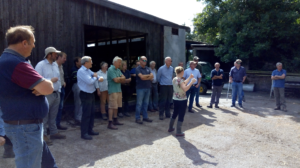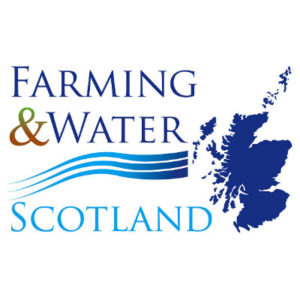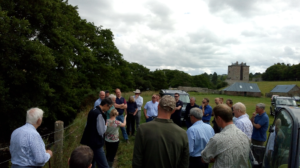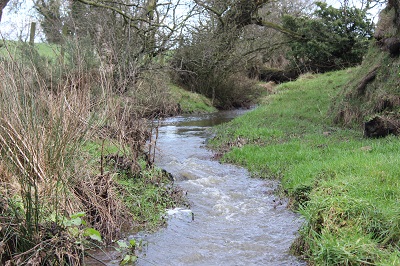Priority catchment awareness meeting; Lothian Priority Catchments – Event summary
19 July 2018Reducing diffuse pollution risks can help you to stay on the right side of the Regulations and protect farm payments, whilst protecting surrounding water quality.
Often driven by rainfall or how we manage farm activities, diffuse pollution can damage surround ing waters. For example, nutrients lost to any ditch, burn, river, loch, wetland or coastal water. This could also represent a direct financial loss to the business.
ing waters. For example, nutrients lost to any ditch, burn, river, loch, wetland or coastal water. This could also represent a direct financial loss to the business.
It is not just an issue at a local level; the effects of diffuse pollution on water quality can often be seen miles away from the source, for example beaches designated as ‘bathing waters’ can be affected by runoff coming from further up the catchment.
Scotland’s priority catchments contain some of the country’s most important waters for conservation, drinking water, bathing and fishing, but they are also at heightened risk from diffuse pollution pressures which will lead to poor water quality. As part of Scotland’s targeted approach to reduce pollution risk, work is underway in a number of ‘priority catchments’. Inspection work is starting on the Lothian Priority Catchments.
Following the introduction of the recent Lothians Priority Catchments this meeting brought together farmers and representatives from the Scottish Environmental Protection Agency (SEPA). SEPA staff gave an insight into what is involved in an inspection and management methods which can be implemented by farmers to reduce the impact of agricultural activities on water quality and promote good practice.
 The group were reminded of GAEC and SMR requirements already in place including buffer strips along watercourses and nitrate vulnerable zones and were directed to the Farming & Water Scotland webpage to learn more about the General Binding Rules (GBRs) which represent a set of mandatory rules which cover specific low risk activities within The Water Environment (Controlled Activities) (Scotland) Regulations 2011 (as amended)
The group were reminded of GAEC and SMR requirements already in place including buffer strips along watercourses and nitrate vulnerable zones and were directed to the Farming & Water Scotland webpage to learn more about the General Binding Rules (GBRs) which represent a set of mandatory rules which cover specific low risk activities within The Water Environment (Controlled Activities) (Scotland) Regulations 2011 (as amended)
 The group also visited a fenced off water margin which prevented cattle access to the burn. This option removed the risk of significant poaching and faecal contamination of the water course, a requirement of the GBR 19. However, it may not always be necessary to erect permanent fencing to prevent significant poaching, all mitigation measures will be site specific. You can request guidance from your local farm advisor or SEPA officer to determine the level of risk and necessary action to prevent diffuse pollution.
The group also visited a fenced off water margin which prevented cattle access to the burn. This option removed the risk of significant poaching and faecal contamination of the water course, a requirement of the GBR 19. However, it may not always be necessary to erect permanent fencing to prevent significant poaching, all mitigation measures will be site specific. You can request guidance from your local farm advisor or SEPA officer to determine the level of risk and necessary action to prevent diffuse pollution.
SEPA will be inspecting all farms in the catchment areas with a focus on all steading and watercourse features on the holding(s).
You can access information that was provided as part of this meeting using the download links below, and further information regarding the diffuse pollution is available from Farming & Water Scotland.
- GAEC 1 – Buffer strips along water courses
- The aim of GAEC 1 rules is to protect water against pollution and run-off.
- Topics: Rural Business
- GAEC 2 – Abstraction of water for irrigation
- The aim of GAEC 2 rules is to protect water resources by licensing abstraction of water for irrigation.
- Topics: Rural Business
- GAEC 3 – Protection of groundwater against pollution
- The aim of GAEC 3 rules is to protect groundwater against pollution.
- Topics: Rural Business
- GAEC 4 – Minimum soil cover
- The aim of GAEC 4 rules is to protect soil against erosion after harvest until the end of winter (winter is up to and including the last day of February).
- Topics: Rural Business
- GAEC 5 – Minimum land management reflecting site specific conditions to limit erosion
- The aim of GAEC 5 rules is to protect soil against erosion in certain situations.
- Topics: Rural Business
- Technical Note (TN665) – Alternative watering for field grazed livestock I – Abstraction systems
- Topics: Water Management
- Technical Note (TN666): Alternative Watering for Field Grazed Livestock II – Pumping Systems
- This technical note looks at the use of three alternative watering systems, based on findings from Scottish Government funded trial work on three farms in Scotland.
- Topics: Water Management and Livestock
- Technical Note (TN699): Agricultural use of Biosolids, Composts, Anaerobic Digestates and other Industrial Organic Fertilisers
- Organic fertilisers such as biosolids, composts, anaerobic digestates and industrial wastes can be useful and cost-effective crop nutrient sources that can improve soil quality. This technical note outlines their use in agriculture.
- Topics: Climate Change, Soils and Water Management
- Farmer’s guide to sourcing and using digestate and compost
- Thinking of using digestate or compost? This guide from Zero Waste Scotland in association with NFUS can help you choose the right product. The guidance gives you key questions to ask to support you through the process of sourcing and using compost and digestate to help make sure the materials will meet your requirements.
- Topics: Climate Change, Soils and Water Management
- Practical Guide: Improving Water Margins for biodiversity and Multiple benefits – Arable farms
- Practical Guide: Improving Water Margins for biodiversity and Multiple benefits – Livestock farms
Sign up to the FAS newsletter
Receive updates on news, events and publications from Scotland’s Farm Advisory Service

